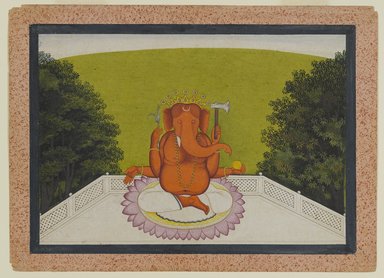
Artist:Indian
Medium: Opaque watercolor on paper
Geograhical Locations:
Dates:ca. 1775–1800
Dimensions: sheet: 8 3/16 x 11 5/16 in. (20.8 x 28.7 cm) image: 6 7/16 x 9 7/16 in. (16.4 x 24.0 cm)
Collections:
Accession Number: 36.242
Image: 36.242_PS4.jpg,
Catalogue Description: The isolated figure of Ganesha, the elephant-headed god, suggests that this page is intended as a frontispiece for a narrative manuscript. Ganesha would be invoked on ritual occasions in order to insure their auspicious completion. Here, the god is seated on a lotus pedestal at the center of a marble terrace with trees to either side and a hill beyond. The figure of Ganesha is painted orange shaded with red-brown. He is seated in padmasana and wears a white dhoti, a seven-pointed jeweled crown, a pair of long necklaces, armlets and bracelets. Ganesha has the crescent moon and third eye of Shiva, and three of his four hands hold attributes: the goad, the axe, a ball of sweets; the fourth hand is shown in the gesture of granting gifts (varada-mudra). The terrace is white and enclosed by a pierced railing on three sides. A narrow dark blue border surrounded by a flecked pink border complete the design. Goswamy has attributed this painting to the Guler artist Nainsukh. Neither the artist nor the subject of the series of this isolated painting has been conclusively identified.